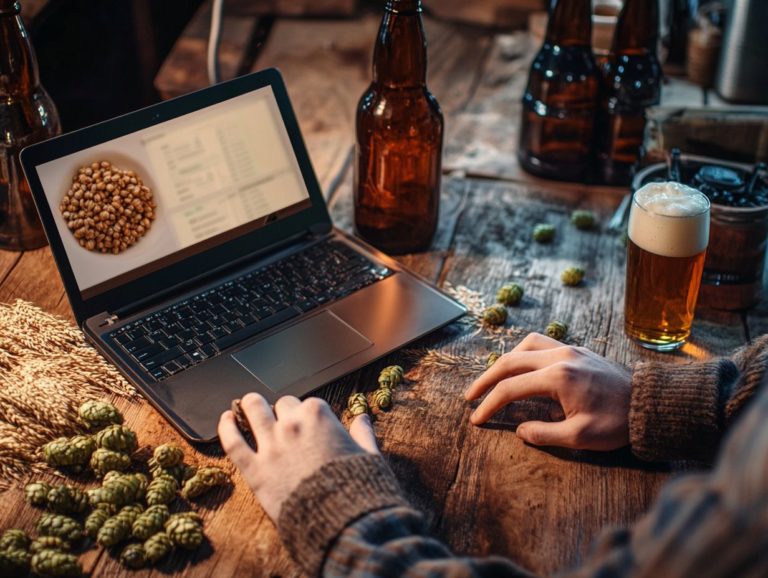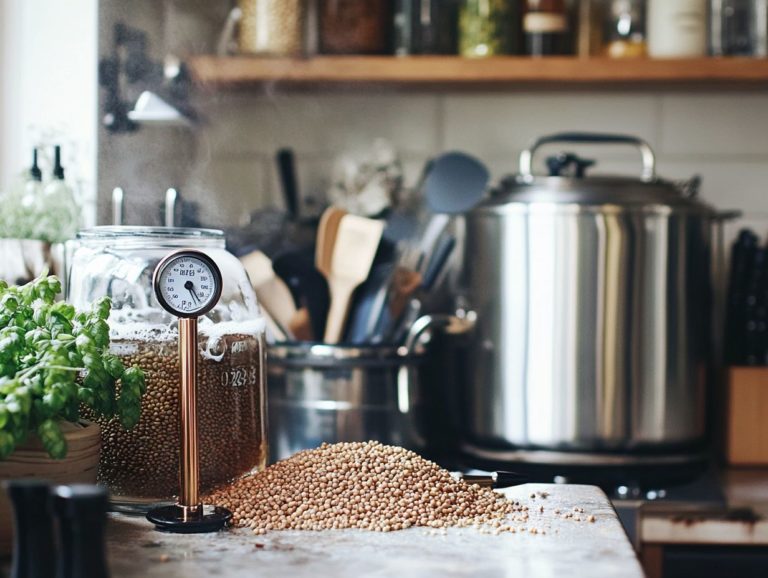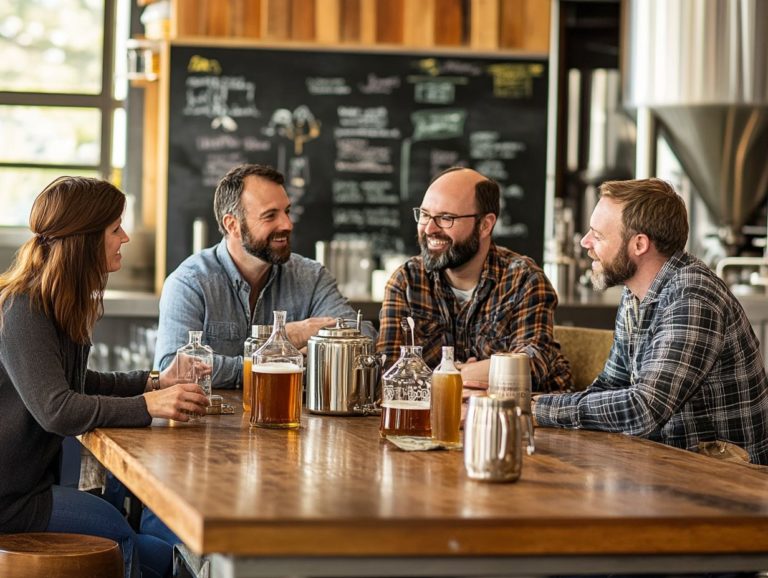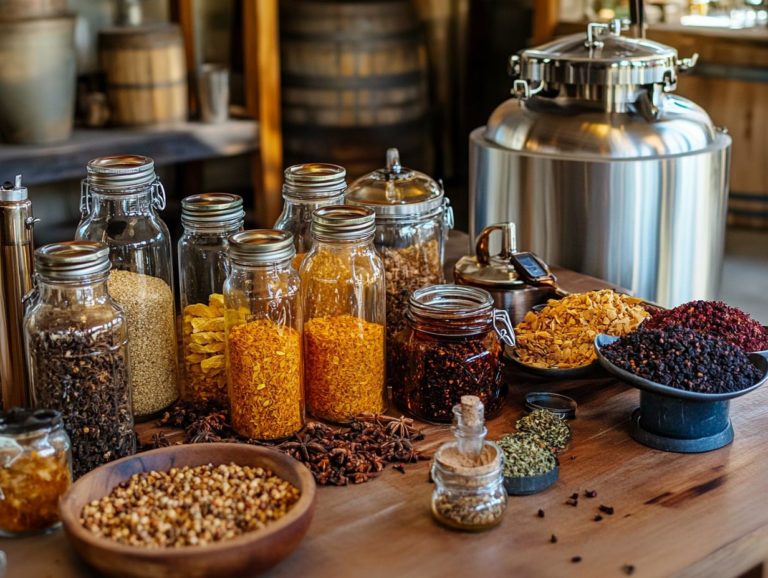What Are Common Home Brewing Mistakes?
Home brewing is an exhilarating journey that empowers you to create your unique beers. However, even minor missteps can lead to disappointing outcomes in your homebrewing process.
Grasping the significance of proper techniques, including precise measurements and thorough cleaning, is essential for any aspiring brewer like you.
This article highlights common mistakes home brewers make, from neglecting cleaning and sanitizing to opting for low-quality ingredients, and provides practical tips to sidestep these pitfalls.
With just a few adjustments, including proper temperature control and ingredient selection, you can elevate your brewing game and truly savor the fruits of your labor.
Contents
- The Importance of Proper Techniques
- Common Mistakes in Home Brewing
- 1. Not Sanitizing Equipment
- 2. Using Low-Quality Ingredients
- 3. Not Controlling Fermentation Temperature
- 4. Improper Mashing Techniques
- Common Mistakes in Home Brewing
- How to Avoid Common Home Brewing Mistakes
- Frequently Asked Questions
- What Are Common Home Brewing Mistakes?
- What are some tips for avoiding mistakes when home brewing?
- What are some signs that a home brewing mistake has been made?
- What are the consequences of making a mistake when home brewing?
- How can I learn to avoid common home brewing mistakes?
- Can Common Home Brewing Mistakes Be Fixed?
Key Takeaways:
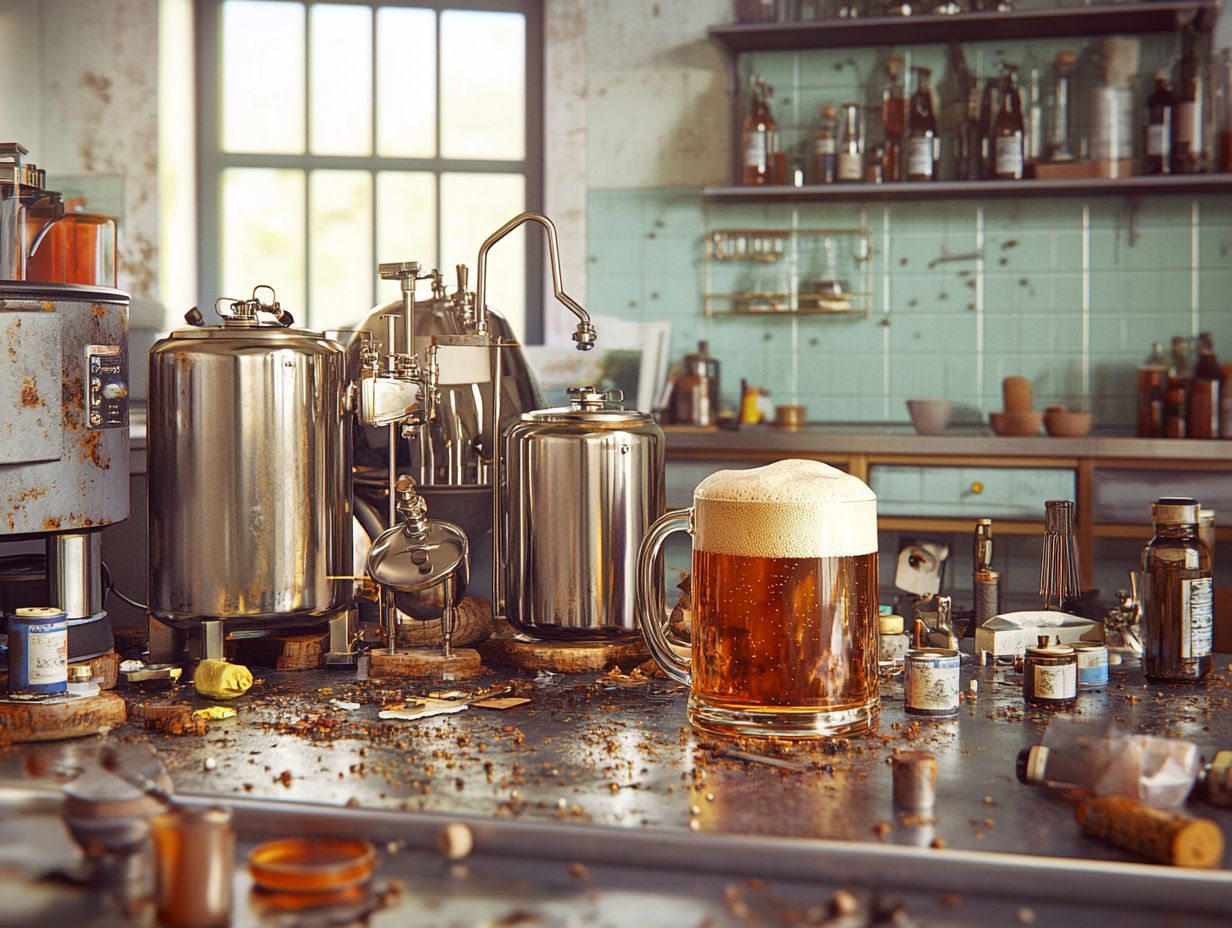
- Proper techniques are crucial for successful home brewing.
- Rushing the process and not following recipe instructions are common mistakes to avoid.
- To avoid mistakes, properly clean and sanitize equipment, use high-quality ingredients, and allow enough time for each step of the process.
The Importance of Proper Techniques
Mastering proper techniques in homebrewing is essential for achieving consistent quality and flavor in your beer. By taking a meticulous approach to each step of the brewing process from selecting the finest ingredients to making precise measurements during fermentation and boiling you ensure that your final product is enjoyable and safe to savor.
Emphasizing practices like thoroughly cleaning and sanitizing your equipment, controlling fermentation temperatures, and adhering to a well-crafted recipe can drastically minimize the common pitfalls that home brewers often face. By embracing these best practices, you elevate your brewing experience, celebrating both the artistry and the science of crafting exceptional beer at home. Consider taking notes throughout the process to learn and improve with each batch.
Why Are Proper Techniques Important in Home Brewing?
Mastering proper techniques in home brewing is crucial for crafting high-quality beer that meets your expectations and delights your palate, ensuring the best outcome from your wort (the liquid extracted from the malted grains before fermentation) to the final product.
By meticulously managing these techniques, you can elevate not only the taste but also the aroma and overall experience of your final product. The fermentation process, a pivotal phase, hinges on maintaining the health of the yeast, which directly shapes the character of your beer. Healthy yeast fosters a cleaner fermentation, resulting in a vibrant brew with well-defined flavors. Proper temperature control during fermentation is also essential.
The importance of using high-quality ingredients cannot be overstated; they form the foundation of every successful brew. Each component malt, hops, brewing salts, and water plays an essential role in defining the complexity and depth of flavor that a well-crafted beer can convey. Mastering these techniques is truly essential for any aspiring brewer.
Common Mistakes in Home Brewing
Home brewing is a delightful hobby, yet it comes with its share of pitfalls that can compromise the quality of your final product. Failing to properly clean and sanitize your equipment or opting for low-quality ingredients can lead to undesirable off-flavors and fermentation issues. Not using a proper brew kettle can also affect the boil quality.
Many home brewers underestimate the significance of controlling fermentation temperature and often neglect precise measurement of ingredients. This can result in batches that lack consistency. Rushing through the brewing process and skimping on carbonation time can sabotage even the most promising recipes. Using the right tools and taking detailed notes can help avoid these common issues.
Recognizing these frequent mistakes is your first step toward consistently crafting exceptional beer, ensuring that each batch meets your desired quality and flavor profile.
1. Not Sanitizing Equipment
One of the most critical mistakes you can make in home brewing is failing to properly sanitize your equipment. This oversight can lead to contaminated batches of beer that are far from what you envisioned. Always ensure your fermenter and other brewing tools are properly sanitized to avoid contamination.
Neglecting sanitization can introduce undesirable off-flavors and aromas that detract from the quality of your final product. It s easy to overlook the importance of sanitizing all your brewing tools, including fermenters, bottles, kettle, and measuring cups. Best practices dictate using food-safe sanitizers like Star San or Iodophor. Make sure to mix and apply these solutions according to the manufacturer s instructions.
Thoroughly rinse and air-dry your equipment before use. Contamination from bacteria or wild yeast can disrupt the fermentation process, ruining the flavors, aromas, and carbonation levels of your brew. This is why proper sanitizing and cleaning are foundational steps in homebrewing.
Prioritizing sanitation means you re on your way to brewing exceptional beer!
2. Using Low-Quality Ingredients
Using low-quality ingredients can significantly compromise the flavors and overall quality of your home-brewed beer.
The choice of ingredients, such as hops and brewing salts, is crucial in defining the character of your final product. Hops do more than just add bitterness; they impart essential aromas and flavors, ranging from floral to earthy tones, that can truly elevate your beer’s profile. Meanwhile, brewing salts help you achieve the perfect balance of mineral content in your water, influencing not only the mouthfeel but also the overall taste. Opting for good ingredients and following well-tested recipes can significantly improve your beer’s quality.
By opting for premium ingredients, you can ensure that each batch delivers a delightful experience, highlighting the nuances that arise from careful selection.
The attention you give to ingredient choices creates refreshing and satisfying beer.
3. Not Controlling Fermentation Temperature
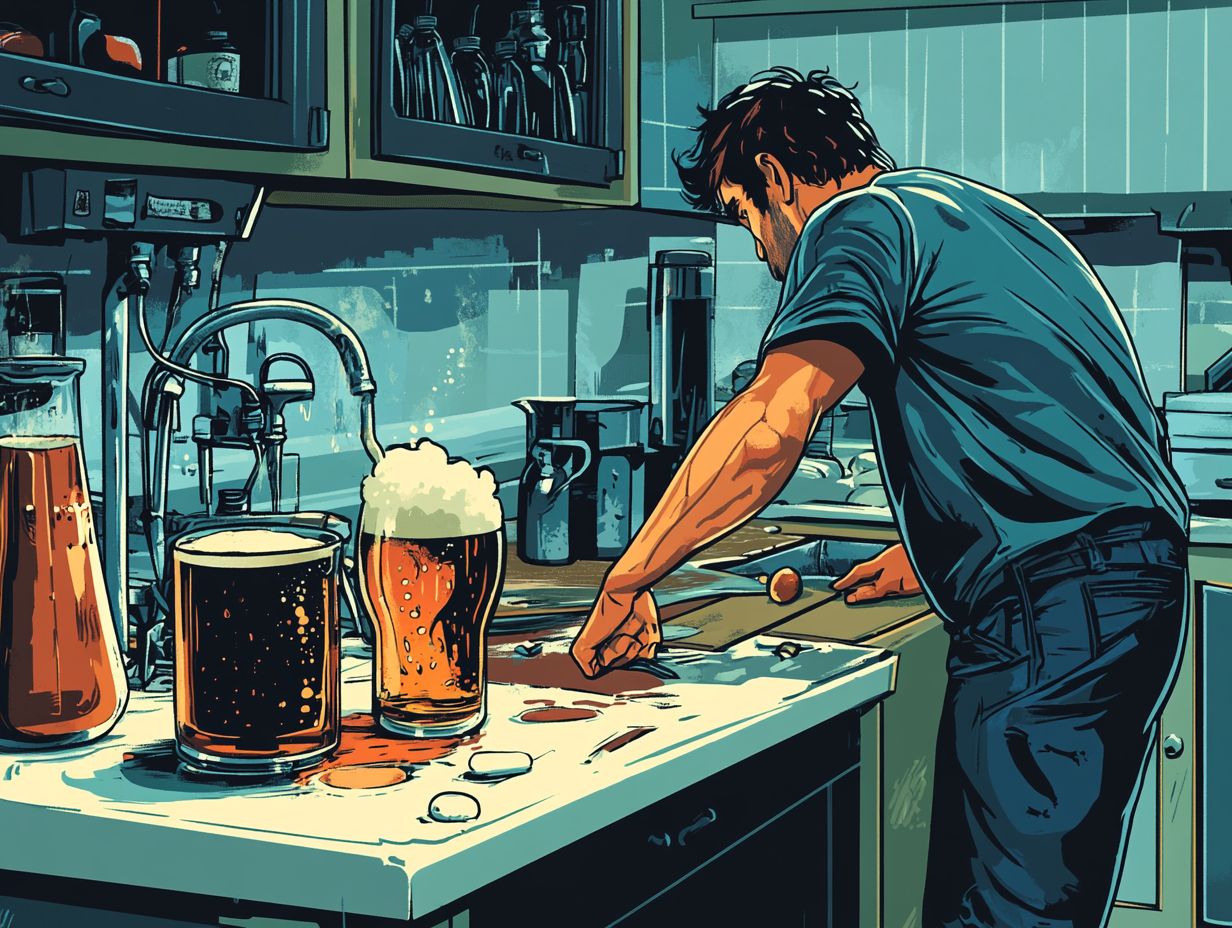
Not controlling fermentation temperature is a mistake you ll want to avoid, as it can lead to off-flavors and unwanted characteristics in your beer. This oversight is significant because fermentation is a sensitive process where yeast transforms sugars into alcohol and carbon dioxide, directly influencing the flavor profile and aroma of your brew. Proper temperature control, along with accurate gravity measurements, can ensure a smooth fermentation process.
When fermentation temperatures fluctuate, yeast behavior can become unpredictable, causing stress that results in undesirable byproducts like fusel alcohols or esters, which can overpower the intended flavors. By ensuring a stable temperature range, you allow the yeast to operate efficiently, promote a clean fermentation, and enhance the desirable traits of your final product.
Brewing is an art. Treat temperature as a crucial element to craft balanced and flavorful beer!
4. Improper Mashing Techniques
Improper mashing techniques can lead to a subpar extraction of sugars and flavors from the grains during your brewing process. This phase is pivotal, as it allows the enzymes in the malted grains to break down starches into fermentable sugars, contributing not just to the alcohol content but also influencing the overall flavor profile of your beer. The quality of your wort is highly dependent on accurate mashing techniques.
It’s essential to maintain the optimal mash temperature. For instance, if you opt for a lower temperature of around 148 F (64 C), you’ll promote the activity of beta-amylase, resulting in a fermentable wort. On the other hand, raising the temperature closer to 156 F (69 C) boosts the action of alpha-amylase, creating a fuller-bodied beer.
Thus, grasping the importance of precise mashing techniques is crucial for achieving the desired wort quality and the nuanced flavors that will define your final product.
Common Mistakes in Home Brewing
5. Not Following Recipe Instructions
Neglecting to follow recipe instructions can lead to significant inconsistencies in your brewing process and the final product. This is especially crucial for both novice and seasoned brewers alike, as the precise measurement of ingredients like hops, malt, and yeast is vital in determining your beer’s flavor, aroma, and overall quality. Taking detailed notes while following recipes from trusted sources like Brew Cabin can help ensure consistency and quality.
When measurements are off, you risk encountering undesirable tastes, imbalances, or even fermentation issues. These complications can ultimately compromise the drinkability of your beer. By strictly adhering to established brewing recipes, you ensure that your brews are replicable and cultivate an appreciation for the delicate balance of elements that contribute to your desired profile.
Properly measured ingredients and careful attention to each step, including the boil and fermentation stages, enhance the overall quality of your beer. Over time, these practices will not only deepen your understanding of the brewing process but also enhance your skills and elevate your enjoyment of this rewarding craft.
6. Rushing the Process
Rushing the home brewing process can lead to disappointing beer. Each step demands the appropriate time and attention for the best results. Ensuring each phase, from mashing to carbonation, is given sufficient time is critical.
Take fermentation, for example. This is a crucial stage where yeast works its magic, converting sugars into alcohol and crafting the beer s distinctive flavor profile. If you cut this phase short, you risk introducing undesirable off-flavors. Proper temperature control and gravity measurements are essential in this stage.
Then there s carbonation, which occurs during a second fermentation process or by adding priming sugar. This step enhances the mouthfeel and aroma, transforming your drinking experience. Using high-quality tools can help achieve the right balance during carbonation.
Allowing sufficient time for both fermentation and carbonation ensures that the natural complexities and richness of the beer are fully realized. This dedication results in a well-rounded brew that truly showcases your brewing skills. By honoring these timelines, you can create a final product that not only tastes exceptional but also reflects the commitment and effort you’ve invested in each batch.
7. Not Measuring Accurately
In home brewing, failing to measure your ingredients accurately can lead to inconsistencies and unexpected flavors in your final product. This highlights just how crucial precise measurements are for achieving a balanced and enjoyable brew. From the amount of malt you use to the timing of your hop additions, every detail plays a vital role in shaping the overall flavor profile of your beer. Adding the right hops at the right time can make a significant difference.
If you’re eager to craft the perfect pint, consider utilizing tools like digital scales and calibrated measuring cups to uphold accuracy. Keeping detailed records of each brewing session will refine your techniques and enhance your understanding of how ingredient variations affect the outcome.
Ultimately, embracing precision doesn t just elevate your home brewing experience; it sparks creativity and enables you to experiment while still maintaining a high standard of quality.
8. Not Allowing Enough Time for Carbonation
Neglecting to allow ample time for carbonation can leave you with flat beer that misses out on its essential character.
The carbonation process is crucial for developing the final flavor profile. It introduces bubbles that make your beer feel more satisfying and enjoyable, highlighting aromatic compounds. Without the right level of carbonation, even your most meticulously crafted brews can fall disappointingly short, leading to a lackluster drinking experience.
Achieving that perfect balance often demands patience. The yeast works its magic on the sugars, producing carbon dioxide over time. Don’t rush this vital stage your beer deserves the best! Rushing can compromise not just the body and texture, but the overall quality of your beer.
By giving carbonation the time it deserves, you ensure that your creations reach their peak in flavor and satisfaction.
How to Avoid Common Home Brewing Mistakes

Home brewing can be an exciting and rewarding hobby, but to truly excel, it’s essential to steer clear of common mistakes. By honing in on best practices and dedicating yourself to refining your brewing techniques, you can elevate your brewing experience.
This commitment will lead you to achieve optimal results, transforming your brewing endeavors into a remarkable experience.
1. Sanitize Equipment Properly
Properly sanitizing your equipment is crucial to prevent contamination and ensure high-quality beer in your home brewing efforts. This important step safeguards the flavor and integrity of your brew while protecting against off-flavors that can spoil an otherwise perfect batch.
As you embark on your brewing journey, it s vital to use good cleaning products such as iodophor, Star San, or bleach solutions. These powerful agents help kill germs and create a sterile atmosphere where your primary yeast culture can truly thrive.
By maintaining rigorous hygiene standards throughout every stage of brewing, you support the fermentation process while minimizing the risk of infection. This attention to detail leads to a more satisfying and enjoyable experience, whether you’re a novice or a seasoned brewer.
For more tips and guidance, visit Brew Cabin, a resourceful platform established by brewing expert Matt Giovanisci.
2. Use High-Quality Ingredients
Using top-notch ingredients is essential for you to achieve the desired flavors and overall success in home brewing. Sourcing quality hops and malts can dramatically influence both the flavor profile and brewing performance of each batch you create.
When selecting hops, pay close attention to the variety and origin, as these elements dictate bitterness, aroma, and flavor notes. For example, American hops often impart bright citrus and pine characteristics, while European varieties might offer earthy or floral nuances that can elevate your brew.
Your choice of malts is also crucial; pale malts create a light and crisp base, whereas roasted malts contribute deeper color and rich flavors. By prioritizing quality in these ingredients, you can enhance the intricacies of your crafted beers and lead to a more refined and enjoyable drinking experience.
3. Master the Art of Fermentation Temperature!
Controlling fermentation temperature is crucial for ensuring robust yeast activity and achieving the desirable flavor profile in your beer.
Maintaining the right temperature during fermentation can dramatically influence how the yeast performs, which in turn shapes the final characteristics of your brew. Yeast thrives within specific temperature ranges typically between 65 F to 75 F for ales and 45 F to 55 F for lagers.
To monitor these temperatures effectively, consider investing in thermometers or digital temperature controllers that offer real-time feedback. It s essential to regularly check and adjust the ambient temperature using techniques like cooling jackets or heated fermentation vessels. This helps prevent sudden fluctuations that could stress your yeast.
Paying close attention to these factors allows you to craft a balanced flavor profile, minimize off-flavors, and enhance the overall character of your beer.
4. Follow Recipe Instructions Carefully
Following recipe instructions with care is crucial for maintaining the consistency and quality of the beer you brew. This meticulous approach ensures that each batch aligns with the intended flavor profile and characteristics you desire.
To adhere to your recipe effectively, consider employing precise measuring techniques, as these can significantly impact the final taste of your brew. Utilizing tools like a calibrated scale for malt and hops, or a graduated cylinder for liquids, greatly enhances accuracy and minimizes variability.
Understanding how different ingredients interact such as the role of yeast in fermentation or the effects of water chemistry on overall flavor enables you to make informed adjustments. This holistic perspective elevates your brewing process and allows you to refine your craft with every batch you create.
Don’t wait make the switch to high-quality ingredients today and taste the difference!
5. Allow Enough Time for Each Step
Taking the time for each step in the brewing process is key to unlocking the finest flavors and carbonation levels.
Fermentation can span from just a few days to several weeks, depending on the different types of yeast you choose and the flavor profile you aim to achieve. During this period, the yeast diligently converts sugars into alcohol and carbon dioxide, orchestrating a complex medley of flavors.
Patience during this stage is essential; rushing can result in incomplete fermentation or those pesky off-flavors that no one wants. Equally important is the carbonation timeline.
After fermentation, letting your brew condition and carbonate properly enhances its mouthfeel and aroma, ultimately leading to a more balanced and enjoyable beverage.
By allowing sufficient time for these processes, your final product becomes a gratifying experience that truly reflects your dedication and care as a brewer.
6. Measure Accurately
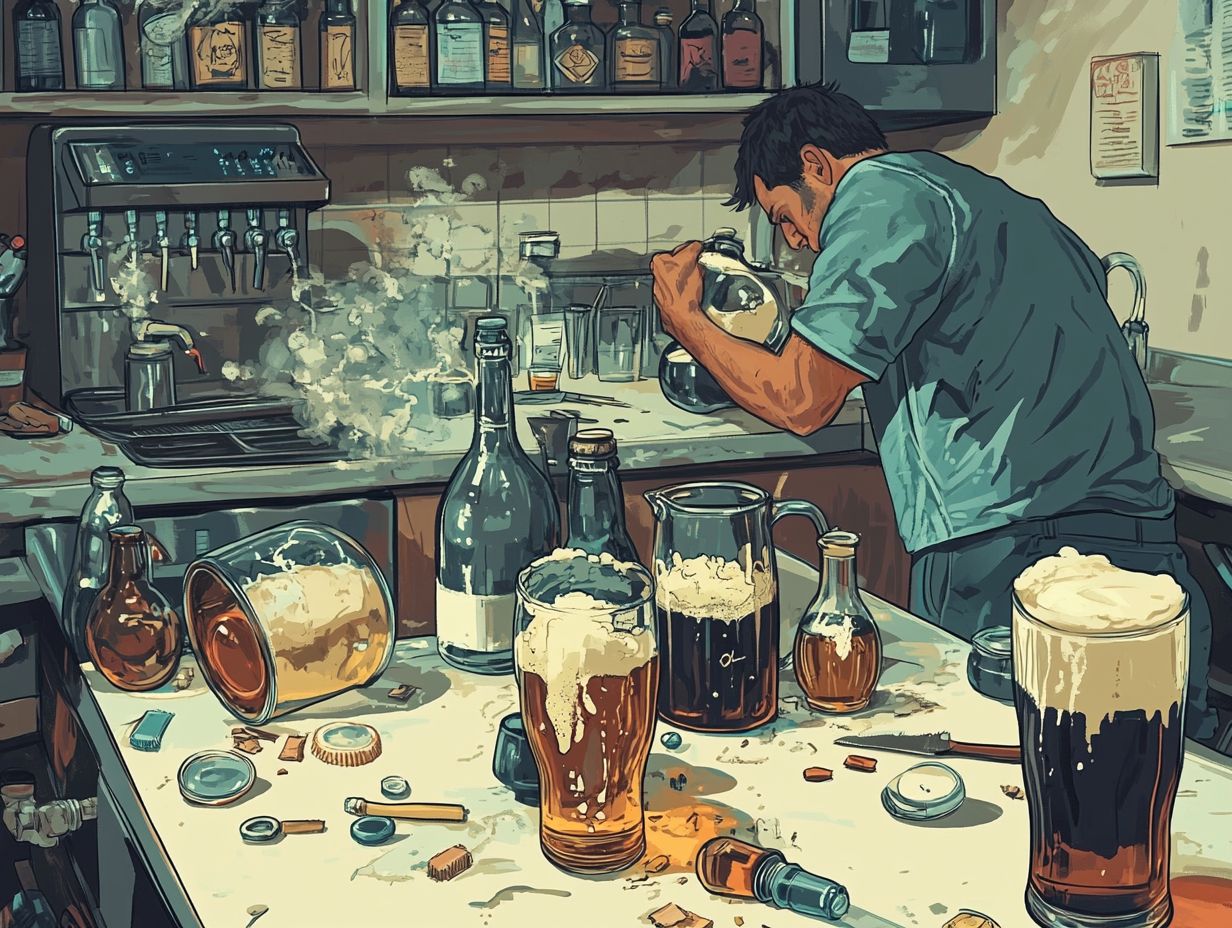
Accurate measurements of ingredients are essential for you to achieve the desired outcomes in home brewing. This precision not only influences the flavor and aroma of your final product but also plays a critical role in the fermentation process.
By utilizing tools like digital scales, graduated cylinders, and measuring cups, you can ensure that hops, malt, water, and yeast are added in the correct proportions.
Techniques such as using hydrometers will further assist you in gauging the density of the beer compared to water, allowing you to track the progress of fermentation.
By focusing on these details, you ll be able to craft beers that consistently meet your expectations, turning your creative visions into outstanding brews that truly showcase quality and character.
7. Be Patient with Carbonation
Exercising patience with carbonation is essential for you achieve the ideal fizziness and mouthfeel in your beer. This step is crucial! It involves closely monitoring the progression of CO2 production.
During carbonation, the yeast consumes the remaining sugars, producing gas that dissolves in the beer, resulting in that delightful effervescence you crave.
To keep a close eye on this process, you ll want to check the pressure inside your fermentation vessels and look for any signs of keg or bottle bulging, which can indicate that things are getting a bit too lively.
Utilizing a thermometer will help you maintain the perfect temperature for yeast activity. Patience is your ally here; rushing this carbonation phase could lead to flat beer or, even worse, overly carbonated bottles that might explode, ruining all the hard work you ve put in.
Frequently Asked Questions
What Are Common Home Brewing Mistakes?
Common home brewing mistakes include not properly sterilizing equipment, not controlling fermentation temperature, and not using quality ingredients.
What are some tips for avoiding mistakes when home brewing?
To avoid common home brewing mistakes, make sure to properly clean and sanitize all equipment before use, closely monitor fermentation temperature, and invest in high-quality ingredients.
For more expert advice, refer to resources like Brew Cabin by Matt Giovanisci.
What are some signs that a home brewing mistake has been made?
If your beer has an off-flavor, unusual aroma, or a cloudy appearance, it could be a sign of a home brewing mistake.
Other signs include inconsistent carbonation, low alcohol content, or improper use of hops.
What are the consequences of making a mistake when home brewing?
Making a mistake when home brewing can result in off-flavors, spoiled beer, or even potential health hazards.
It can also be costly in terms of wasted ingredients, time, and unsuccessful use of hops.
How can I learn to avoid common home brewing mistakes?
Learn to avoid common home brewing mistakes by researching best practices, attending classes or workshops, or joining a home brewing community such as Brew Cabin where experienced brewers, like Matt Giovanisci, can offer advice and tips.
Ready to brew? Start experimenting with these tips today!
Can Common Home Brewing Mistakes Be Fixed?
Common Fixes for Brewing Mistakes
Some common home brewing mistakes can be fixed. For example, a beer with off-flavors, which are unwanted tastes in the beer, can sometimes be improved through aging or blending.
Adjusting the hops may also help. Striving for a mistake-free brewing process from the beginning is always the best approach!
Don t let mistakes ruin your brew! Let s explore how to fix these common issues quickly.


